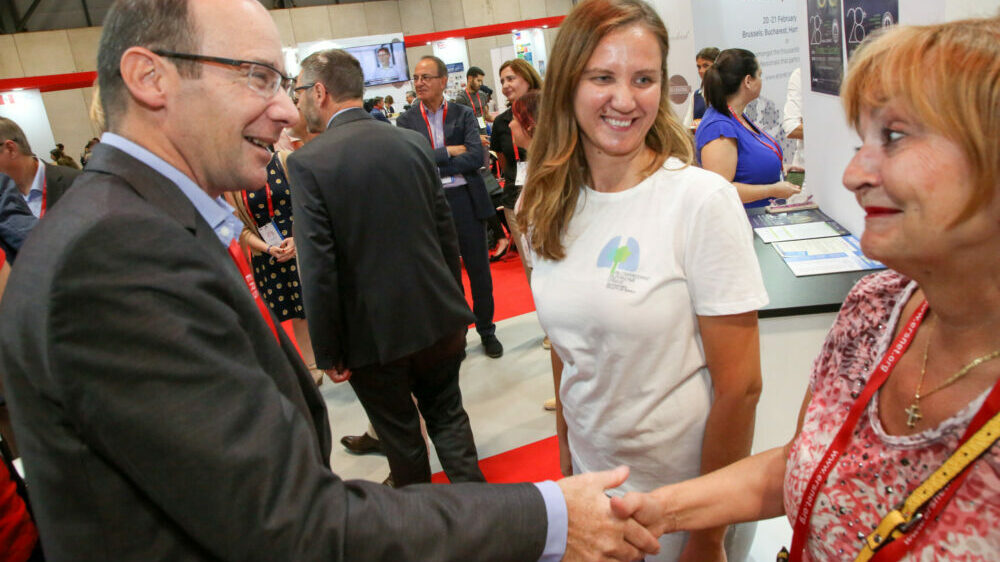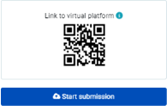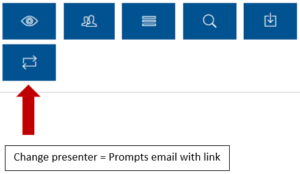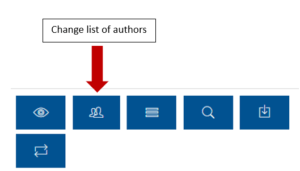
The Society
More than 35,000 clinicians, scientists and allied health professionals from over 160 countries are part of the ERS community
Become an ERS member


Please note: this page is continuously updated and therefore the information below is subject to change and new content may be added.
An abstract is a shortened version of a paper, offering several opportunities:
The submission period for abstracts is from 5 December, 2024 until 20 February, 2025*. The submission is free.
*Deadline extension until 27 February, 2025
The submission process is completely online. Log into myERS https://my.ersnet.org/, choose the menu ‘Abstract/Cases’ and select “Congress”. Then access the abstract submission platform.
Abstracts that are considered as late breaking must contain novel data and this data must became available for public dissemination only after the standard abstract deadline in February 2025.
The study and results reported should be novel and not simply an extension of previously published work. The late-breaking abstract round is not designed to favour investigators who unintentionally missed the deadline for the regular abstract submission.
The submission period for late-breaking abstract is from 28 April to 30 May, 2025.
Note that the submission is not free, €75 submission fee applies for each LBA submission (non-refundable). For people based in Switzerland additionally 8% VAT will apply.
You must submit your late-breaking abstract online by logging in to myERS and choosing the ‘Abstract’ menu, and then select ‘Congress submission’. The submission period for late-breaking abstracts is from 28 April to 30 May, 2025.
Note that the submission is not free, €75 submission fee applies for each late-breaking abstract submission (non-refundable). For people based in Switzerland additionally 8% VAT will apply.
The most ground-breaking RCT and very late-breaking clinical trial data from all respiratory disease areas. Best RCTs will be presented as part of the ‘Abstracts Leading to Evolution in Respiratory Medicine Trials’ sessions (ALERT).
The submission period for RCT is from 13–27 June, 2025.
Note that the submission is not free, €150 submission fee applies for each RCT abstract submission (non-refundable). For people based in Switzerland additionally 8% VAT will apply.
You must submit your RCT abstract online by logging in to myERS and choosing the ‘Abstract’ menu, and then select ‘Congress submission’. The submission period for RCT is from 13–27 June, 2025.
Note that the submission is not free, €150.00 submission fee applies for each RCT abstract submission (non-refundable). For people based in Switzerland additionally 8% VAT will apply.
Abstracts are intended to present scientific studies and research. If your study is currently ongoing and you only have preliminary data, but it seems relevant or significant, you can submit the abstract. However please be aware that abstracts with incomplete data may have less chance of being accepted for the ERS Congress.
After your abstract is accepted you cannot update the content of your abstract for the official publication as the accepted version will be published, however, you are permitted to present updated information onsite at the Congress.
A maximum of three abstracts (including LBA and RCT abstracts) may be submitted by the same person.
We do not encourage submitting case study abstracts, however, we accept them if they are well-prepared. We do not provide specific templates for this kind of abstract.
You may consider submitting a Clinical Case by the deadline of 20 February, 2025*.
*Deadline extension until 27 February, 2025
Yes, when you are submitting your abstract(s) you will have the opportunity to disclose your Conflict(s) of Interest (COI). A COI statement is only required for the first author.
Title: The title must reflect the abstract’s content. It should provide as much information as possible about the context and the aims of the study. The title should be about 10–12 words long (max. 250 characters are allowed) and should include the scope of the investigation, the study design, and the goal. In general, the title should be a description of what was investigated rather than a statement of the results or conclusions. The abstract’s title should be easy for the reader to understand and should not include jargon or unfamiliar acronyms or abbreviations. The title should not be in capital letters.
Authors: The list of authors should be restricted to those individuals who carried out the study, conceived it, designed it, gathered the data, analysed the numbers, and wrote the abstract. The author who will present the abstract should be listed first. Every listed author should read and approve the abstract before it is submitted. Each author should have participated sufficiently in the research and analysis of data, as well as the writing of the abstract, to take responsibility for the submission, and to qualify as an “author” (as defined by the ICMJE criteria for authorship).
Main text: A good abstract should address the five following questions:
1. “Why did you start?” – Introduction or background: It should summarise, preferably in one sentence, the current knowledge, or state-of-the-art, specifically in relation to the work.
2. “What did you try to do?” – Aims and objectives: State the aim of the study, and ideally include a short statement of the study’s hypothesis. A legitimate scientific study is not done “to prove that something is true” but rather “to find out whether it is true.” While the distinction may seem small, it has a significant impact. A formal hypothesis demonstrates objectivity.
3. “What did you do?” – Methods: Within an abstract, the description of the method should be brief, and much of the details about the procedure must be omitted. However, in a few short sentences, the reader should have a good idea of the design of the study, the context in which it was done, and the types of patients or measurements that were included.
4. “What did you find?” – Results: It is important to give the main results of the study, not in subjective terms (“We found device X to be superior to device Y”) but also in the form of some real data. The findings must include the most important data in the study and the findings on which the conclusions will be based. Do not include a table or figure unless it is essential for demonstrating your results.
5. “What does it mean?” – Conclusions: Space limitations generally limit authors to a single sentence to convey the significance of their findings and potential implications. Include conclusions that are reasonable and backed by the study’s findings. If the study was restricted to certain patients, a particular therapy, or a specific device, the results may not extend beyond these restrictions.
Trade names are allowed in the title only if they are trial names.
All accepted abstracts will be published in a supplement of the European Respiratory Journal (ERJ) by November 2025.
Note that the 2026 abstract submission deadline hasn’t been announced yet. However, it is very likely to follow this year’s timeline:
You can access the:
Instructions and guidelines here or directly from the submission platform
Breathe article “How to write abstract“
The publication of the data should not have occurred prior to the submission of the abstract for presentation at the ERS Congress.
While we understand that publication of the data in journals cannot be delayed, the presentation of the original data should be presented for the first time to the audience at the ERS Congress.
Copyright for abstracts is retained by authors (see on submission Terms & Agreement “11. Copyright, if this abstract is accepted, will be held by the author or employer (as part of the conditions of the author(s)’s employment).”)
The abstracts are not published under a creative commons framework (Creative Commons licencing is most generally used to ‘describe’ how you can ‘use/re-use’ an open access document). The abstracts are not published open access. They are free to access (on both the ERS platforms and when they are published as a supplement of the ERJ), which is different to open access, and are copyright to the author.
The maximum length of an abstract is 1810 characters including characters and spaces in the following: abstract title, abstract body, table, and figures.
N.B. When inserting a table, each cell will subtract a character in addition to its contents. If an image/picture/figure is inserted, it deducts 277 characters.
The list of authors should be restricted to those individuals who carried out the study, conceived it, designed it, gathered the data, analysed the numbers and wrote the abstract. The author who will present the abstract should be listed first. Every listed author should read and approve the abstract before it is submitted. Each author should have participated sufficiently in the research and analysis of data, as well as the writing of the abstract, to take responsibility for the submission, and to qualify as an “author” (as defined by the ICMJE criteria for authorship).
All authors must have a myERS account. If the co-author does not have an account, they can create a myERS account for free.
There is no additional text box available on the submission platform. If an author has more than one affiliation, all additional affiliation(s) must be included in the same text box.
This year, the following abstract sessions are included in the programme:
Use the following link to upload your Congress materials: E-POSTER AND PRESENTATION SUBMISSION LINK
Please ensure that you log in using the email address associated with your MyERS account. Otherwise, you will be unable to submit your materials.
If you are a presenter in an Oral Presentation session:
If you are a presenter in a Poster Session:

Do not attach your ePoster or PowerPoint presentation to e-mails, it will not be processed!
The presenter of the abstract(s) needs to upload the materials via the upload link. Please ensure that you log in using the email address associated with your MyERS account. Otherwise, you will be unable to submit your materials.
The QR Code for printed posters and PowerPoint presentations is now available in the upload platform. Please follow the instructions below to download your QR Code:


Note that incorporating your QR code is not obligatory. We encourage you to use it to facilitate access to your content.
Posters accepted for the ERS Congress (& other ERS Events) can include QR codes.
On the poster, next to the QR code, the following disclaimer must be used:
The ERS is not responsible for and does not endorse the data and information presented on external sites.
As an abstract poster presenter, you will need to:
Use the link to upload your congress materials by the deadline: upload link. Please ensure that you log in using the email address associated with your MyERS account. Otherwise, you will be unable to submit your materials.
The e-poster and the printed poster do not need to fully match. Especially, after submitting the e-poster, authors can add new information to the printed poster.
No, only presenters need to disclose their Conflicts of Interest, if any.
Recommended specifications for e-poster:
ERS Templates can be found here as a recommendation, authors can still use their own template.
As an abstract OP presenter, you will need to:
ERS Templates can be found here as a recommendation, authors can still use their own template.
The presentation numbers will be available from mid-July in the Congress online programme.
Unfortunately, it’s not possible to modify the schedule and presentation type of an abstract.
Alternatively, you may change the presenter of your abstract so that one of your co-authors presents the abstract instead.
Please note that changes to the abstract presenter and the list of authors will only be possible until Sunday, 21 September 2025. Afterwards, the two functions will be disabled from the MyERS of the submitting author.
Poster presenters must bring their printed poster with them directly. However, authors could check directly with their hotel. In that case, please note that ERS does not take any responsibility should the poster be lost.
No, the Congress venue in Amsterdam will not have a printing service available.
The status of all abstracts will be available on the myERS account of the submitting author. Please refer to the table below to know when it will be available:
| Round | Call open/close dates | Notification* |
| First call | 5 December – 20 February, 2025* *Deadline extension until 27 February, 2025 |
June 2025 |
| Late-Breaking Abstract (LBA) | 28 April – 30 May, 2025 at 23:59 CEST | Early July, 2025 |
| Randomised Controlled Trial (RCT) | 13 – 27 June, 2025 at 23:59 CEST | Early August, 2025 |
*The notification timeline may slightly change.
When the notification of acceptance is sent out, successful authors will receive:
Unfortunately, the status will only be available once the notification emails are sent out according to the timeline below:
| Round | Call open/close dates | Notification* |
| First call | 5 December – 20 February, 2025* *Deadline extension until 27 February, 2025 |
June 2025 |
| Late-Breaking Abstract (LBA) | 28 April – 30 May, 2025 at 23:59 CEST | Early July, 2025 |
| Randomised Controlled Trial (RCT) | 13 – 27 June, 2025 at 23:59 CEST | Early August, 2025 |
All abstracts are graded anonymously by a panel of at least three reviewers on a scale from one (lowest) to six (highest), with an average score of three minimum for acceptance, on the basis of the following criteria:
Based on these elements, the decision is taken to accept or reject abstracts for Congress. When the allocation starts, ERS officers also consider the limitations of slots available in the congress programme.
You cannot modify your abstract’s body or title after the submission deadline without any exceptions.
Until the submission deadline, you can edit or delete the abstracts and still submit the new version. There is no need to inform the ERS office.
After you receive the notification that your abstract has been accepted to the ERS Congress, you will be able to modify only the list of authors, the order of the authors listed and the presenter from the myERS account of the submitting author. Any changes in the list of authors will be possible until Sunday 21 September, 2025.
Please note that changing the abstract presenter will only be possible until Sunday, 21 September 2025. Afterwards, the function will be disabled from the MyERS account of the submitting author.
It is possible to update the list of authors, adjust the order, and assign a new presenter directly from the MyERS account of the author who submitted the abstract.
To proceed, kindly follow the steps below:

To change the presenter: Click the circular arrow icon (bottom left):
Please note that changes to the list of authors will only be possible until Sunday, 21 September 2025. Afterwards, the function will be disabled from the MyERS account of the submitting author.
It is possible to update the list of authors, adjust the order, and assign a new presenter directly from the MyERS account of the author who submitted the abstract.
To proceed, kindly follow the steps below:

To update the list of authors: Click the second icon from the left (two user silhouettes) to:
Withdrawals are possible after you receive the notification that your abstract is accepted. Please contact ERS Abstracts with the complete abstract withdrawal form.
Please note that withdrawal forms sent after Sunday, 21 September 2025 will be processed after the Congress. However, the abstract text and all related materials will not be displayed in the virtual Congress platform.
It’s not possible to change the submission category. However, the organisers of the session and the ERS Congress Programme Committee might move your abstract into a different category.
No, after your abstract is selected for the ERS Congress, the allocation (schedule and presentation type) is decided by the ERS Congress Programme Committee, and it’s not possible to modify it.
To apply for sponsorships and grants, please access the abstract submission platform by following these steps:
Notification to those who succeeded will be sent out by mid-June 2025, once the official abstract acceptance/rejection notifications have been sent out.
No, if you have not received a confirmation of sponsorship/grant by the end of June 2025, you have not been allocated with a sponsorship, travel grant or any other type of award for the ERS Congress 2025.
No, grants and sponsorships are specifically attributed to carefully selected candidates, rendering sponsorships and grants nontransferable.
No, grants and sponsorships are related to your abstract submitted and accepted for the ERS Congress 2025 and not any other ERS event.
No, grants and sponsorships are not offered for the late-breaking abstract submissions.